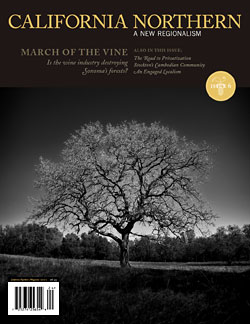Notes from the Field
Morgan Hill, Santa Clara County
By Jordana Finnegan
A few years ago, I moved to Morgan Hill, a small agricultural town at the edge of the Silicon Valley, bounded by mountains on both sides. Morgan Hill was a convenient midway point from which my husband and I could make our respective commutes, and I found myself slowly adjusting to a landscape and culture that contrasted sharply with that of Santa Cruz, my hometown. After the duplex we were planning to rent in the downtown area fell through, we decided to rent a remodeled villa west of town, in the foothills above Uvas Reservoir. Initially, I found myself drawn to this remote rural canyon whose gently rolling brown hills and expansive blue sky seemed untouched by the sprawling strip malls and tract housing developments spreading throughout the valley. The culture in Morgan Hill is a strange mixture of rural ranchers, wine growers, and recently arrived commuters from the high-tech industries of the Silicon Valley, a combination of old and new California cultures. Still, there is something about this dry, sun-baked valley that evokes a preindustrial time and place, untouched by the hustle and commotion of the Bay Area.
Folsom Lake, Placer County
By Kevin Knauss
When we moved from Elk Grove to Granite Bay, near Folsom Lake, a few years ago, we did so only to be closer to our parents. I grew up in Citrus Heights and spent a few summers lifeguarding at Folsom Lake in the ’70s, but didn’t venture there much after that. Back then, I would never have guessed that I would one day find myself visiting the lake every weekend, rain or shine. It’s a State Recreation Area, so it’s very popular, but I imagine there are few who are as attached to it as I am, or who take advantage of its hospitality regardless of the season.
If it’s summer, I can feel the familiar crunch of decomposed granite underneath my bike tires as I pull onto the trail. The air is heavy with the smell of grass and dust, and the temperature in the Sacramento Valley often breaks 100 degrees for days in a row. I can barely keep the sweat out of my eyes as I ride to the top of the levee to gaze out onto the blue water. There are boaters, Jet Skis, and sunbathers everywhere I look, but the only animals around are the lizards that sometimes stir along the trail and the occasional rattlesnake.
Benicia, Solano County
By Anthony Pignataro
Eight years or so had passed since my girlfriend, Angela, last visited the small town of Benicia, located on the shore of the Carquinez Strait—which empties into the northeastern part of the San Francisco Bay—just a couple of hours from our Sacramento home. I had barely heard of it, but she said it was quaint, and a nice place to look at the bay and pop into an antique store or two, so we made a day of it. Though it lacks the bohemian feel of other seaside artistic towns, today Benicia is predominantly known for its glassblowers and its otter-filled wetlands. We found ourselves more drawn to Benicia’s historical roots, though. It used to house a massive military arsenal and a pre–Civil War corps of camel-mounted cavalry. And, oddly enough, it was once California’s state capital.
Since 1849, five cities have served as the home of the California Legislature, and Benicia filled the role from February 1853 to February 1854. In fact, the Benicia capitol building is the only pre-Sacramento seat of government still standing. It’s a cramped, two-story affair, with imposing columns, brick walls, creaky wooden stairs, and a $3 admission charge. The building is open to the public every day, though with the perpetual budget crisis in the contemporary capital, you never know when that might end. After she claimed to know no more than we did, the park ranger at the door eventually conceded that she had heard the building might soon be open only on the weekends.
Gardisky Lake, Mono County
By Susan McCarthy
For a long time, my family has gone camping near Tioga Pass in the Eastern Sierra Nevada. After many years, some of us got interested in trout, and then obsessed with trout. I’m no expert, but I do have a favorite trout lake, and it’s not the wildest, the loveliest, or the most convenient.
As three of us began to fish one summer, it looked like we wouldn’t catch a thing. My neighbor had everything a person could need to catch bass in Ohio. The veterinarian had featherweight fishing gear for backpacking. I had Tweety, a child’s fishing rod from the general store in Tuolumne Meadows. It was yellow plastic with a picture of the Warner Brothers character. With our three different approaches, we figured at least one of us would succeed. But we failed everywhere.
We failed at Saddlebag Lake, and that had looked like a cinch. Lots of people catch fish there. It’s in the Inyo National Forest, and it has near-urban convenience: bathrooms next to the parking lot and an office that doubles as a lunch counter, where they sell tackle, BLTs, pie, and even tickets for a water taxi into the back country. Saddlebag attracts osprey that appreciate the rainbow trout stocked by Fish and Game. In the deep water by the dam, we could see these trout steadfastly ignoring our lines.
The above are excerpts of Issue 3’s Notes from the Field

